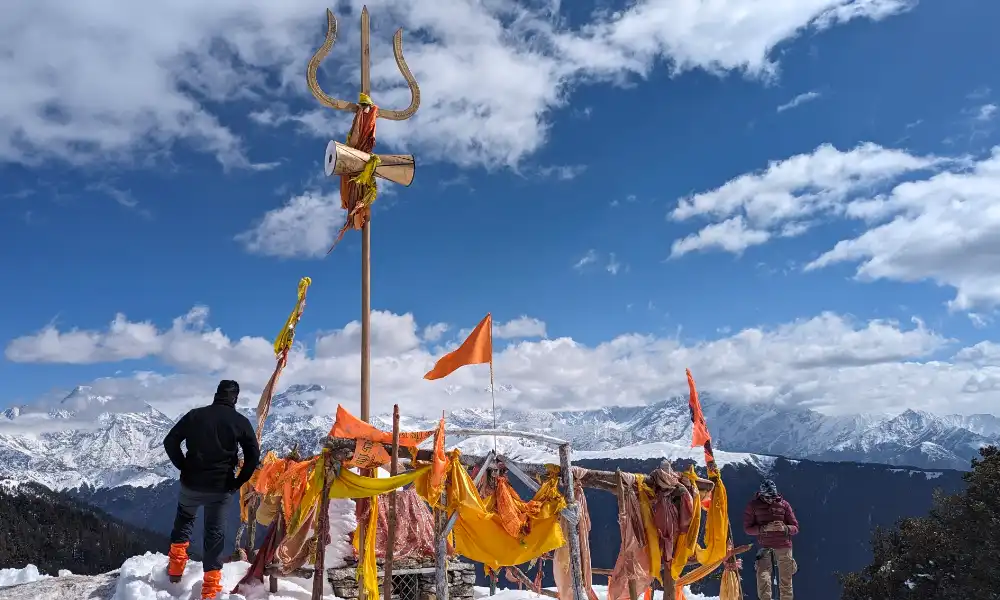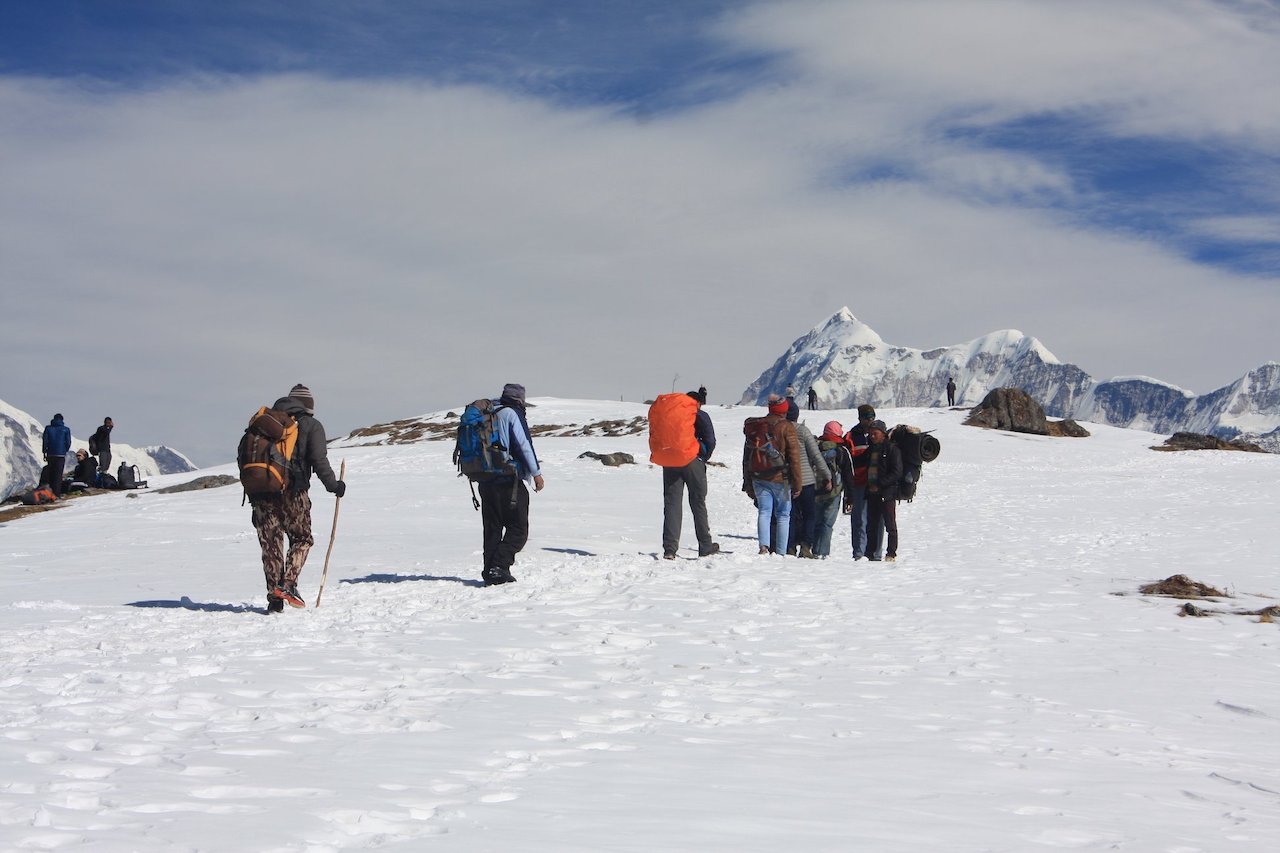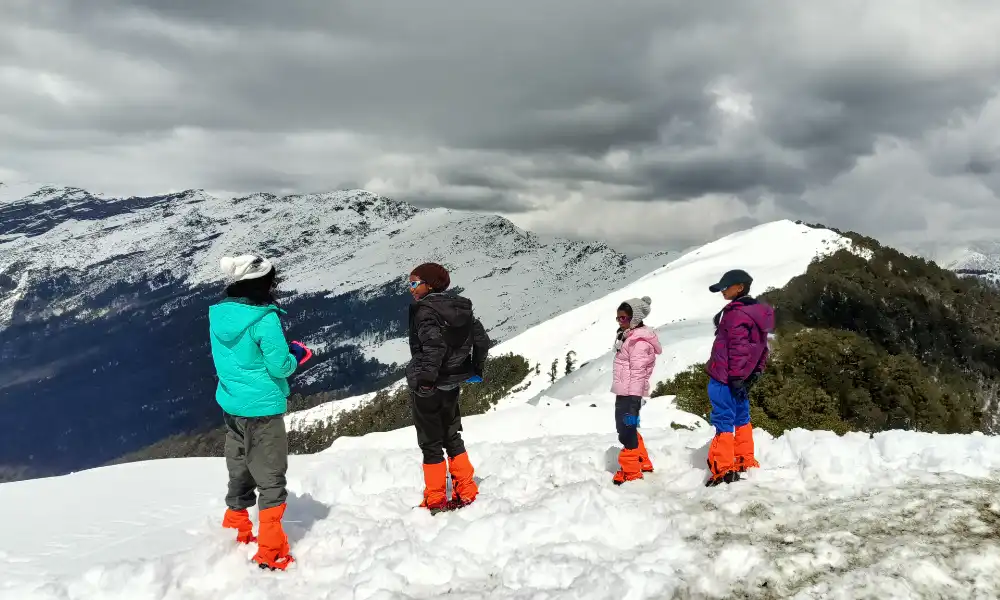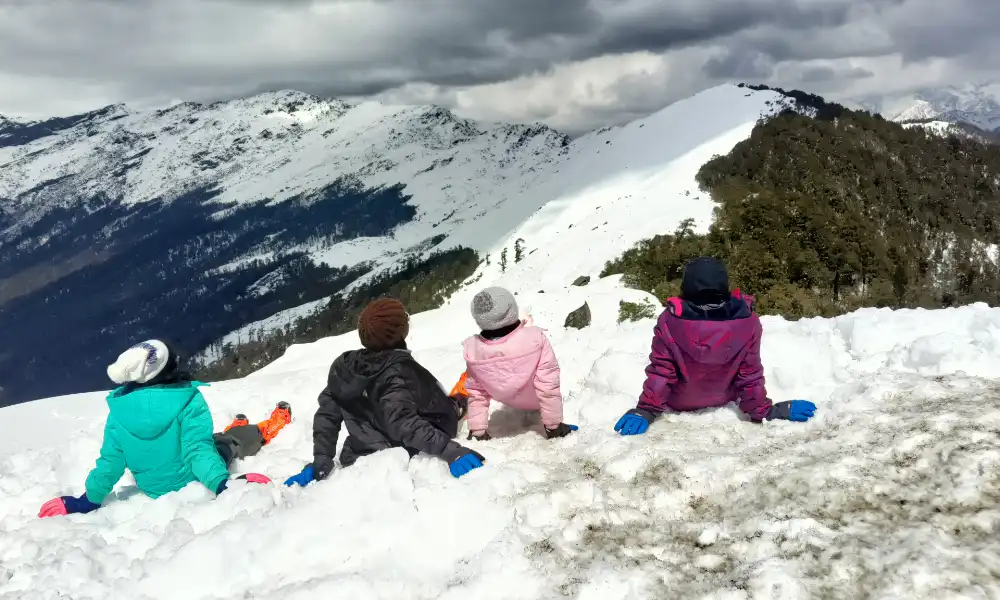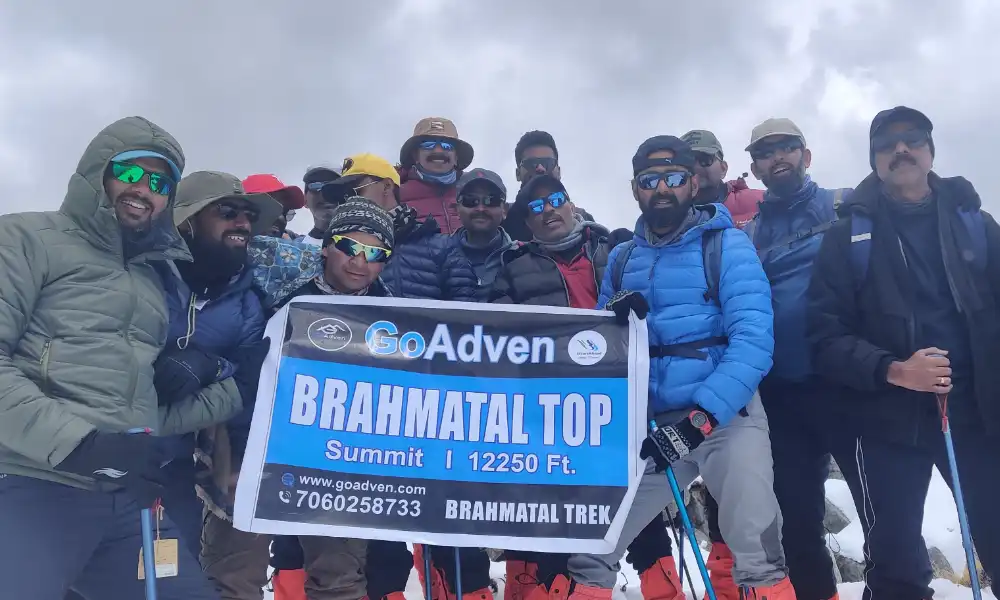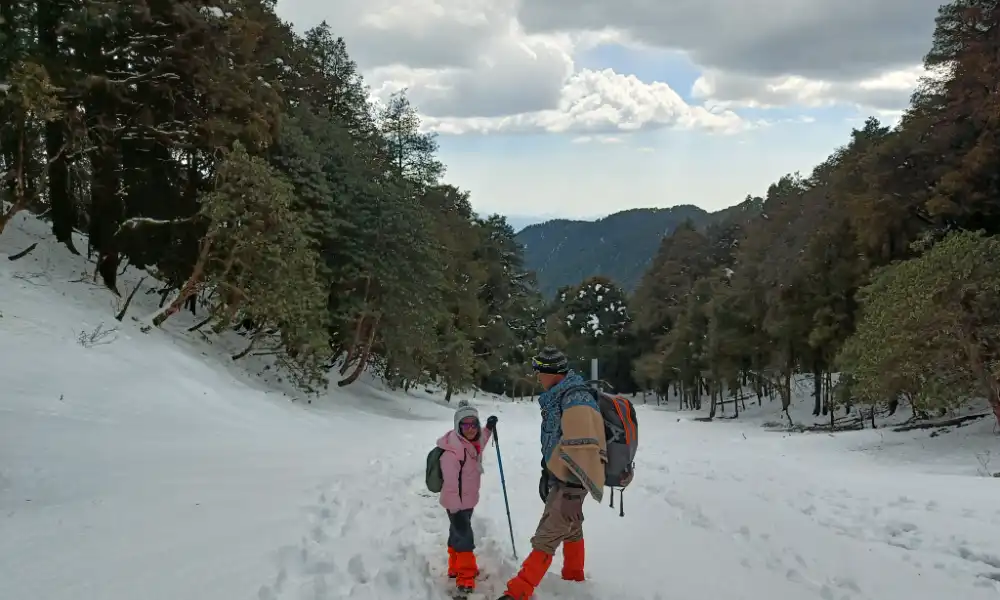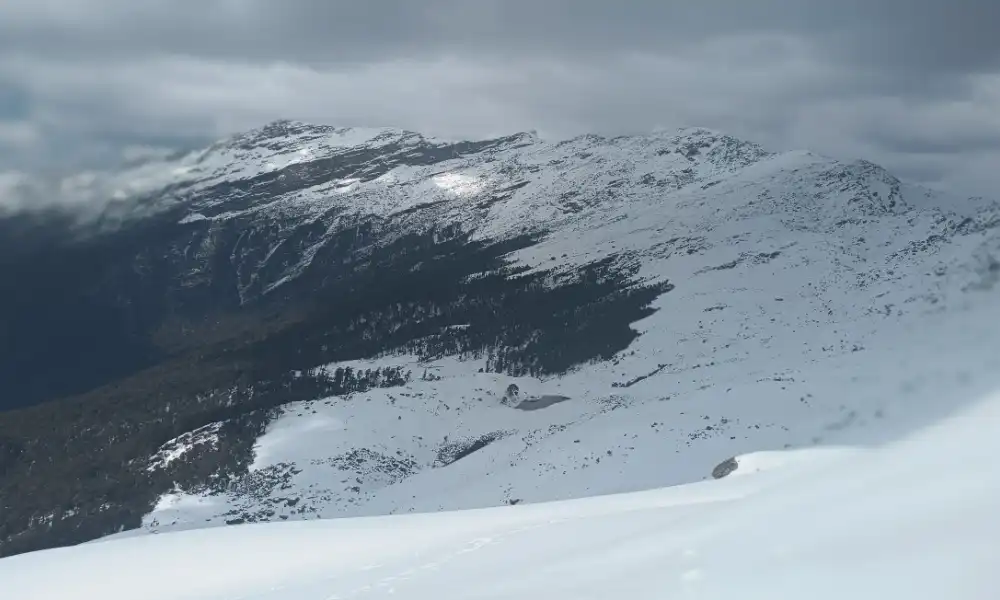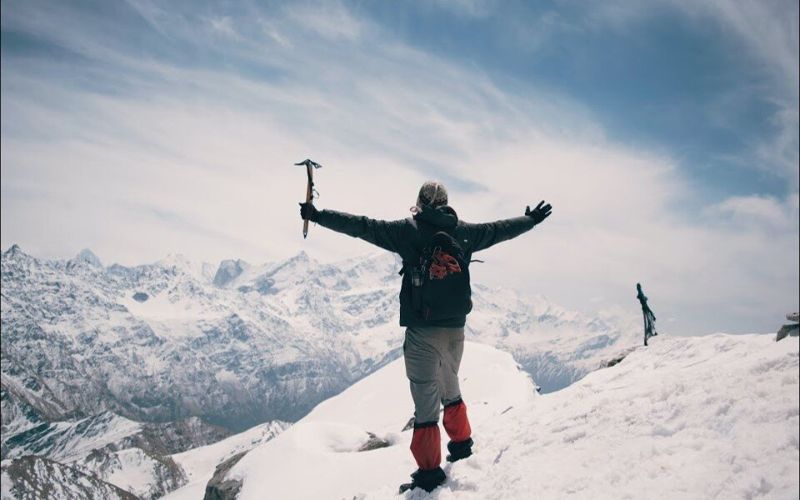Description
-
- Grade: Easy To Moderate
- Duration: 6 Days
- Trekking : 24 KM
- Trail Type – Round trail. The trek starts and ends at Lohajung
- Rail Head – Rishikesh is the nearest rail head to the base camp
- Airport- Jolly grant airport Dehradun
- Base Camp – Lohajung
- Best Season
- Winter Trek (Mid Nov – Mid Feb)
- Spring Trek (Mid Feb – Mid Apr)
- Snow – Mid December to Mid March.
- Services – from Lohajung to Lohajung
- Meals – Meals while on trek & at Hotel/Guesthouse (Veg & Eggs)
- Stay – Guest house, Camping on multiple sharing basis
The Brahmatal Trek, situated in the Garhwal region of Uttarakhand, India, offers a mesmerizing journey through the Himalayas, characterized by stunning vistas, serene alpine lakes, and dense forests. This moderate-level trek typically spans over 6 to 7 days, covering approximately 22 to 26 kilometers of scenic terrain.
The highlight of the trek is undoubtedly Brahmatal Lake, a glacial waterbody surrounded by towering peaks, steeped in Hindu mythology as the meditation site of Lord Brahma.
Trekkers are treated to panoramic views of snow-capped Himalayan peaks like Nanda Ghunti and Trishul, while traversing through picturesque villages and diverse flora and fauna. Whether undertaken in the summer months or during the enchanting winter season, the Brahmatal Trek promises an unforgettable adventure into the heart of the Himalayas, blending natural beauty with spiritual serenity.
Important Informations
Who can participate
- Age; 7 years.
- First timer can apply; previous trekking experience is more appreciated.
- The trekker must be fit and have sufficient stamina to cover 4 km of distance in 35 minutes without a stress.
- Maximum age depends on your fitness level
- The climber should be able to carry a 10-12 kg backpack.
Health Awareness
- Pulse rate at rest must be in between (60 to 90 beats per minute)
- Blood Pressure Reading must be in between (DIASTOLIC 75 – 85, SYSTOLIC 100 - 130 mm Hg)
- Respiratory rate at rest must be in between (12 to 20 breaths per minute)
- Should not have Liver and kidney issues
- Should not have Diabetes Mellitus, Bronchial Asthma, Epilepsy, Heart problems, Hypertension etc
- No pacemaker implant
- People with the Sinus issues please contact to trek coordinator before booking the trek
- If your BMI is not normal, Please contact our Trek coordinator before Trek booking.
Note:
- Junior trekkers (below 15 years) should have a company of parent/guardian.
- Trekkers between 15 to 18 years can come solo with the disclaimer form signed by parent/guardian.
- Medical & Disclaimer Form (Mandatory Documents ; Click here
Trek Essential
- Clothing:
- 1 Nos. Moisture-wicking base layers -tops and bottoms (available for purchase at basecamp)
- 2 Nos. Dry fit T-shirts
- 2 Nos. Insulating mid-layers (fleece)-(available for purchase at basecamp)
- 1 Nos. Down Jacket (available for purchase or rent at basecamp)
- 2 Nos. Trek Pants (available for purchase or rent at basecamp)
- 2 pair Undergarments -(available for purchase at basecamp)
- 1 pair woolen and waterproof hand gloves (available for purchase or rent at basecamp)
- 1 Nos. Waterproof and windproof outer shell (jacket and pants)- (available for purchase or rent at basecamp)
- 3 Nos. Extra pairs of socks (available for purchase at basecamp)
- 1 Nos. woolen camp (available for purchase at basecamp)
- 1 Nos. Suncap (available for purchase at basecamp)
- 1 Nos. Balaclava or Neckband (available for purchase at basecamp)
- 1 Nos. quick dry towl ( for basecamp use)- (available for purchase at basecamp)
- 1 Nos. hand towl (for trek)- (available for purchase at basecamp)
- poncho or waterproof pant and jacket
- Footwear:
- 1 pair Sturdy and waterproof hiking boots with good ankle support and traction(available on rent at basecamp)
- 1 pair Camp shoes or sandals for rest stops or basecamp.
- Backpack:
- 50-60 ltr Comfortable and sturdy backpack with hip belt and chest strap (available on rent at basecamp)
- 10-20 ltr daypack(for summit day or during offloading backpack)- (available for rent 0r purchase at basecamp)
- Backpack cover (available on rent at basecamp)
- Hydration and Cutlery:
- 2 Nos. Sufficient water bottles or hydration reservoir(each one ltr)- (available for purchase at basecamp)
- Water purification tablets or filtration system
- 1 nos Thermos bottle(availoable for purches or rent at basecamp)
- 1 nos. Leakproof Tiffin Box(available for purchase or rent at basecamp)
- 1 nos. plate(available for purchase or rent at basecamp)
- 1 nos. Tea Mug (available for purchase or rent at basecamp)
- 1 nos. spoon
- Food and Snacks:
- Lightweight and high-energy snacks such as trail mix, energy bars, and dried fruit.
- Energy drinks and hydration packs.
- Navigation and Safety:
- Headlamp or flashlight with extra batteries (available for purchase or rent at basecamp)
- Whistle
- Multi-tool or knife
- First-Aid Kit:
- Carry these medicines with you, easily accessible at all times. Do not take any medicine unless you have consulted your trek leader.
- Diamox (1 Strip): It is important to carry Diamox as part of the Live Saving Drugs.
- Dolo 650 (5 tablets): This is a paracetamol. It helps to tackle fever, mild pain
- Avomine (4 tablets): Carry this especially if you are prone to motion sickness. Pop one-half hour before the start of your road journey.
- Combiflam (5 tablets): Take a combiflam if you get a sudden twist of the leg or a muscle strain. It is a pain reliever. It also contains paracetamol.
- Digene (4 tablets): Take it if you feel the food that you’ve taken is undigested. Alert your trek leader immediately. It could be a sign of AMS.
- ORS (6 packs): Consume a pack of ORS water at least once a day, usually mid-day when you are in the middle of your trek. It replenishes essential salts lost while trekking. Tip: It also makes cold water easier to drink.
- Knee Brace (optional): Carry this if you are prone to knee injury or have known issues of knee pain.
- personal medicins if any.
- Cold and sun Protection:
- Sunscreen (SPF 30+)
- Moisturiser
- Lip balm with SPF
- Sunglasses with UV protection
- Wide-brimmed hat or cap
- Personal Hygiene and Toiletries:
- Toilet paper
- Hand sanitizer
- Biodegradable soap or Hand wash (for washing hands and utensils)
- Toothpaste, Toothbrush
- sanitary pads or menstrual products (for womens)
- Other Essentials:
- 3 xerox copy of Identification (Adhar card or passport)
- Medical form and registration form.
- Cash and/or credit/debit cards
- Mobile phone and power backup devices (power banks)
- Camera or smartphone for capturing memories
- Trash bags for packing out waste
- Reusable Plastic Bags (for clothes safety inside backpack)
- Optional Extras:
- 2 Trekking poles for added stability.(available on rent at base camp Lohajung)
- Binoculars for wildlife viewing
Note: if you want to purchase or rent trekking essential from basecamp . please talk first to your trek coordinator to check availability.
Cost Term
Normally Go Adven India expect to carry your personal luggage on your own, if you wish to offload your backpack, you can give it to Mule.
Charges of offloading backpack(if you are not able to carry your own backpack):-
INR 1600/- Bag/ whole trek
The backpack cannot weight more than 10 kgs. Backpack should have waterproof cover. Suitcases/strolleys/ bags will not be allowed. only trekking bags allowed)
Trek Cost - Rs 6,990 (Lohajung to Lohajung )
Transportation Cost - Rs 2,000 (Rishikesh to Lohajung & back to Rishikesh as per itinerary) (optional)
GST - 5% (Mandatory) on Trek Fees
Off load Backpack - Rs 1,600/ bag/ whole trek (if not able to carry)
How to Reach:
Pick-Up Information: 6 AM
Arrival Time in Rishikesh: Ensure you arrive by 5:30 AM.
Pick-Up Location:
Tapovan, Rishikesh
Landmark: State bank of india, opposite Balak nath Mandir Tapovan, Rishikesh
How to reach Rishikesh:
Flight Options:
Fly Directly to Dehradun
Recommended for an added rest day in Rishikesh.
Frequent connections from major metro cities.
1-hour bus ride from Dehradun to Rishikesh or can hire a cab directly from airpot to your stay in tapovan, Rishikesh.
Fly to Delhi:
Arrive before 9:00 PM
Take a bus to Rishikesh from Delhi.
Train Options:
Dehradun Shatabdi (Train no: 12017)
Departs New Delhi Railway Station at 6:45 AM, arrives in Haridwar at 11:30 AM.
Frequent buses from Haridwar to Rishikesh (1-hour journey).
Dehradun Jan Shatabdi (Train no: 12055):
Leaves Hazrat Nizamuddin at 3:20 PM, arrives in Haridwar at 7:33 PM.
Stay overnight in Tapovan, Rishikesh.
Overnight Bus Option:
Overnight Volvo AC Bus
Depart from Delhi’s ISBT Kashmiri Gate.
Frequent departures, taking about 8-9 hours.
Aim for a bus that arrives before 5:30 AM.
Additional Notes:
Last metro from the airport to New Delhi is at 11:15 PM.
Drop-Off Information:
Drop-Off Point:
Tapovan, Rishikesh
Arrival Time: Aim to reach Rishikesh between 6:30 PM and 7:30 PM.
Subsequent Travel Arrangements:
Plan any further travel after 10:00 PM to ensure you have enough time for your arrival and any necessary transitions or stay Rishikesh overnight.
Planning Your Return Flight/Train Booking
When planning your return, keep the following in mind:
- Trek Ends on Day 6:
- Do not book your return tickets for Day 6.
- Book for Day 7 instead.
- Return from Dehradun:
- Consider Day 7 as your booking date.
- Return from Delhi:
- If flying from Delhi, opt for an evening flight on Day 7 or a morning flight on Day 8.
- Early Morning Flights on Day 9:
- You can book early morning flights, but ensure they depart after 8:00 AM.
- Avoid flights between 6:00 AM and 8:00 AM to ensure you have enough time to reach Delhi.
ATM Points and Mobile Connectivity on the Brahmatal Trek
ATM Points:
- Dewal: The last reliable ATM is located in Dewal, a small town you'll pass through on your way to Lohajung, the base camp for the trek.
- Pre-Trek Withdrawal: It’s highly advisable to withdraw sufficient cash from Rishikesh, Karnaprayag, or Dehradun before heading to the base camp.
- Tip: Carry enough cash for the entire trek, covering transportation, food, and emergency expenses, as ATMs are scarce once the trek begins.
Mobile Connectivity:
- Lohajung (Base Camp): Basic mobile connectivity is available, primarily for Jio and Airtel networks. Other providers like BSNL and Vodafone may have limited or no coverage.
- During the Trek: Expect almost no mobile connectivity once you leave Lohajung and head deeper into the mountains. Signal is typically lost as you ascend to higher altitudes.
- Emergency Communication: It’s advisable to inform your family of your plans before starting the trek. You may find weak signals from Jio and Airtel at certain high points, but reliability is not guaranteed.
Emergency Preparedness:
- Guides and Leaders: Trek leaders and local guides are usually well-prepared for handling emergencies in areas without mobile connectivity.
Summary:
- ATM: Last reliable ATM in Dewal; withdraw cash beforehand.
- Mobile Connectivity: Limited in Lohajung; almost none during the trek (Jio and Airtel may work occasionally).
Safety Measures at GoAdven India (GAI)
GoAdven India (GAI) is celebrated as one of the best trekking companies in India, renowned for its expertly curated treks and unwavering commitment to safety. The thrill of trekking in the Himalayas comes with inherent risks, making it essential for both beginners and experienced trekkers to prioritize safety. Here’s an overview of the comprehensive safety measures GAI implements before and during treks, ensuring every trekker can embark on their adventure with confidence.
Pre-Trek Safety Measures
a. Pre-Trek Briefings
At GAI, we believe that a well-informed trekker is a safer trekker, making pre-trek briefings a cornerstone of our safety strategy.
- Importance of Thorough Briefings: These sessions ensure that participants are prepared and aware of what to expect, aligning everyone on the trek itinerary, safety protocols, and overall expectations.
- Topics Covered:
- Itinerary Overview: Detailed insights into daily routes, camping sites, and significant landmarks to help trekkers mentally prepare for challenges.
- Safety Protocols: Emphasis on altitude sickness awareness, emergency procedures, and correct use of safety equipment, including recognizing AMS symptoms.
- Expectations and Guidelines: Discussion of the code of conduct, environmental preservation, and adherence to the trek leader's instructions.
b. Medical Safety
The health and well-being of trekkers is a top priority at GAI.
- First Aid Kits and Medical Supplies: Every team carries well-stocked first aid kits to manage injuries and common ailments, including medications for altitude sickness.
- Protocols for Acute Mountain Sickness (AMS):
- Education and Prevention: Trekkers learn about AMS symptoms and preventive measures during briefings.
- Monitoring: Leaders and medical personnel closely monitor trekkers for AMS signs.
- Treatment and Response: Immediate actions are taken if AMS symptoms are detected, including rehydration and potential evacuation.
c. Technical Safety
GAI prioritizes technical safety for navigating the challenging terrains of the Himalayas.
- Use of Appropriate Gear: Trekkers are equipped with essential gear such as trekking poles, sturdy boots, harnesses, ropes, helmets, and crampons.
- Regular Maintenance of Equipment: All gear is regularly inspected and maintained to ensure optimal safety and functionality.
- Training on Technical Gear: GAI provides training on the proper use of equipment, covering techniques for balance, safety procedures, and gear handling.
Emergency Protocols
GAI understands the need for comprehensive emergency protocols in remote environments.
a. Emergency Response Plan
- Immediate Response: Trained guides are equipped to provide first aid and stabilize patients during emergencies.
- Coordination with Local Authorities: Established protocols for communicating with local medical facilities and rescue teams ensure prompt assistance.
b. Evacuation Procedures
Efficient evacuation procedures are critical for the safety of trekkers.
- Use of Ground Transport: GAI arranges ground transport for less critical cases.
- Quickest Route to Medical Facilities: Pre-arranged agreements with local transport providers ensure rapid response times to medical facilities.
Commitment to Safety
At GoAdven India, we uphold the highest safety standards in the trekking industry. Our commitment extends beyond local regulations, striving to exceed them to ensure each trek is not only adventurous but also safe and enjoyable. With our meticulous preparations and robust safety protocols, trekkers can embark on their journeys with confidence and peace of mind.

